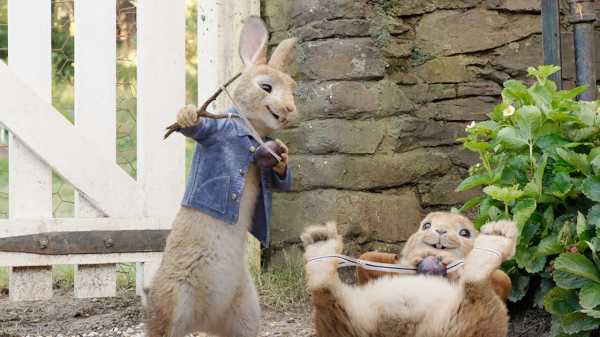
Last Saturday, a day after the opening of “Peter Rabbit,” Will Gluck’s
new and free adaptation of Beatrix Potter’s stories, Kenneth Mendez, the president and C.E.O. of the Asthma and Allergy Foundation of America,
issued both a statement on Facebook and an open
letter criticizing the film’s makers and its studio, Sony, for one particular
scene. In that scene, Peter and the four other rabbits, who are being
threatened and pursued by Tom McGregor (the heir to the venerable Mr.
McGregor’s garden), adopt a new strategy to fight him: knowing that he’s
allergic to blackberries, they use a slingshot to shoot blackberries at
him, and one goes directly into his open mouth. He begins to choke,
feels an anaphylactic episode coming on, reaches into his pocket for his
EpiPen, injects himself with it, and keels over in exhaustion.
The Asthma and Allergy Foundation criticized the filmmakers for making
light of a life-threatening allergy and for depicting the use of an
allergen as a weapon against a gravely allergic person. The statement
warned that the movie could be “disturbing” to children with serious
allergies; some people advocated a boycott. In response, Sony offered an apology.
As a parent of children with severe food allergies, I wish I’d seen the
movie before the controversy broke out, because I’d be curious to see
whether I would have reacted strongly to the scene without having been
alerted to it beforehand. Under the given circumstances, I found that I
agree that the scene spotlights an unpleasant insensitivity, even an
ugly obliviousness, on the part of the filmmakers. Yet, even more, it
throws into sharp relief the over-all tone and import of the film, and,
in the process, reveals other peculiarities that make “Peter Rabbit”
exemplary of recent movies and of the times.
“Peter Rabbit” is a boisterous comedy in which live action (human
characters in realistic homes, landscapes, and towns) is blended with
C.G.I. as seamlessly and as persuasively as in “Paddington 2.” The film
was made by a comedy director (Gluck directed “Easy A” and “Friends with
Benefits”) who, in the script, which he co-wrote with Rob Lieber, has
taken extreme liberties with Potter’s stories. Peter and his family live
in a hollow beneath a tree in rural Windermere, England, and gleefully
filch produce from the garden of their nemesis, the elderly Mr.
McGregor. When Mr. McGregor suddenly dies, the house and garden are
inherited by his great-nephew Tom (Domhnall Gleeson), a Londoner and a
neat freak who is even more hostile to the rabbits than Mr. McGregor
was. But his battles against them are inhibited when he makes the
acquaintance of his neighbor Bea (Rose Byrne), an artist who is the
rabbits’ defender and protector (and also their portraitist). Bea and
Tom fall in love; knowing that Bea also loves the rabbits—and,
especially, their ringleader and brightest personality, Peter—Tom has to
do his rabbit hunting on the sly.
Peter and the other rabbits take advantage of Tom’s self-enforced
restraint to run rampage through his garden and make his life miserable;
Tom, for his part, stealthily takes increasingly forceful action against
them. That’s when, facing real danger, the rabbits prepare to unleash
the blackberry attack, knowing full well its potential consequences.
Peter calls it “the endgame.” For that matter, a bit earlier, as they
plan the attack, the other rabbits are hesitant; Peter’s mild-mannered
cousin Benjamin says that “allergies are serious” and adds, “I don’t
want to get any letters.” (The line wasn’t inserted into the movie after
the controversy arose; it was always there.)
What’s peculiar about “Peter Rabbit” is that, along with its quippy,
often self-referential humor and plentiful (often clever) visual gags,
it features an unusual quantity and degree of violence, which link it to
classic-era Looney Tunes cartoons and Three Stooges shorts. When the
elderly Mr. McGregor keels over, Peter examines him by poking his
eyeball—and, after declaring him dead, gleefully takes credit for
killing him. (Mr. McGregor actually died of a heart attack.) Tom comes slamming at
the rabbits with rakes, hoes, and other garden tools. He installs an
electric fence against the animal intruders, only to have the rabbits
rewire it, electrifying his doorknobs with shocks that blast him,
cannonball-like, against hard stone walls. The rabbits plant snapping
traps and rakes around Tom’s bed, leading to pinchings and clobberings;
they leave various fruits on staircase landings, sending Tom tumbling
down. There’s a repeated gag in which one of the sisters enjoys taking a
hard fall and breaking one rib after another, and a climactic bit,
involving dynamite, that’s nearly apocalyptic.
In another sense, though, the story owes nothing to the action-heavy,
character-thin antics of Bugs Bunny or Daffy Duck, Elmer Fudd or Road
Runner and Wile E. Coyote. Rather, Gluck’s “Peter Rabbit” is thoroughly
composed and intricately characterized; the rabbits, no less than the
humans, are given elaborate backstories and large emotional arcs that
the plot is devoted, at length, to illustrating, explicating, and
resolving. Peter and his sisters—Flopsy, Mopsy, and Cottontail—are
orphans; their father was killed and eaten by Mr. McGregor, and Peter’s
familiar blue jacket is actually his father’s. Their mother died, too,
making Bea is the closest thing to a parent that the rabbits have.
Meanwhile, Peter is a mischievous, temperamental, vain, proud hothead,
who, in a quiet moment, acknowledges that it’s his “character flaw” to
do “stupid and reckless” things. (Oddly enough—or perhaps not oddly at
all, given that the movie is written by two men—Bea is given the least
backstory.) When romance blooms between Bea and Tom, Peter’s response is
partly one of a practical worry for the rabbits’ safety. But, as the
violence ramps up between Tom and Peter, even Benjamin wonders whether
Peter has an ulterior motive—jealousy. In other words, with Bea as
Peter’s virtual mother, “Peter Rabbit” is something of a story about
Peter trying to come to terms with a stepfather; the comedic drama links
Peter’s mean streak to his emotional deprivation and trauma, and it
takes him carefully through the paces of his rise to self-recognition
and maturity.
It is precisely this strain of emotional realism that makes the allergy
subplot, slight though it is, so repellent. The movie’s other varieties
of violence are exaggerated, cartoonish, not just in depiction but in
substance. Few kids have experience with electrical engineering or have
dynamite at home; most kids know other kids with severe allergies.
(Despite its explosive extremes and intricate, Rube Goldberg-esque
calculation, there are no guns and no knives; Gluck clearly knows that
certain things aren’t to be trifled with.) Meanwhile, the same emotional
realism turns “Peter Rabbit” didactic, dutiful, tedious. Its mechanistic
moralism, seemingly distilled from screenwriting classes and studio
notes, is the sort that marks so many movies now—ones for adults as well
as those for children—imparting values in the form of equation-like
talking points, which prepare viewers not for life but for more, and
similarly narrow, viewing.
Gluck clearly relishes the slapstick action that the characters incite,
the situations inspire, and the technology enables, and he invests it
with his own sense of exuberant discovery, which is minor but authentic.
When it comes to life lessons, however, he dons his official hat and,
far from doing any learning in the course of the action, merely
dispenses the official line. That’s why the scene involving a
life-threatening allergy is all the more conspicuous: while the rest of
the movie marches in lockstep with its edifying narrative, that scene is
out of place. It doesn’t follow the script.
Sourse: newyorker.com






